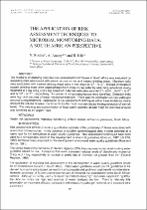 ResearchSpace
ResearchSpace
Application of risk assessment techniques to microbial monitoring data: a South-African perspective
JavaScript is disabled for your browser. Some features of this site may not work without it.
- ResearchSpace
- →
- Research Publications/Outputs
- →
- Journal Articles
- →
- View Item
| dc.contributor.author |
Rodda, N

|
en_US |
| dc.contributor.author |
Amory, A

|
en_US |
| dc.contributor.author |
Kfir, R

|
en_US |
| dc.date.accessioned | 2007-03-27T11:50:39Z | en_US |
| dc.date.accessioned | 2007-06-07T10:09:17Z | |
| dc.date.available | 2007-03-27T11:50:39Z | en_US |
| dc.date.available | 2007-06-07T10:09:17Z | |
| dc.date.issued | 1993 | en_US |
| dc.identifier.citation | Rodda, N, Amory, A and Kfir, R. 1993. Application of risk assessment techniques to microbial monitoring data: a South-African perspective. Water Science and Technology, vol. 27. 04 March, pp 145-150 | en_US |
| dc.identifier.issn | 0273-1223 | en_US |
| dc.identifier.uri | http://hdl.handle.net/10204/2102 | en_US |
| dc.identifier.uri | http://hdl.handle.net/10204/2102 | |
| dc.description.abstract | The feasibility of applying microbial risk assessment techniques in South Africa was evaluated by assessing risks associated with enteric viruses in raw and treated drinking water. Maximum daily risks associated with treated drinking water were in the range 2x10(-2) - 7x10(-1). If levels of viruses in treated drinking water were approximated from those in raw water by assuming reductions during treatment of 4 log, 5 log and 6 log, maximum daily risk estimates were 4x10(-2) - 4x10(-1), 5x10(-3) - 1x10(-1) and 5x10(-4) - 1x10(-2), respectively. A number of complicating factors were identified. Detection limits were high and volumes of water monitored were low. There was no information on viral pathogen removal during treatment. Application of risk assessment techniques within these limitations clearly showed the volume of water monitored to be the most important factor limiting detection of low risk levels. The sampling and concentration of large water volumes (at least 100 l) for microbial analysis was identified as an urgent need. | en_US |
| dc.format.extent | 382019 bytes | en_US |
| dc.format.mimetype | application/pdf | en_US |
| dc.language.iso | en | en_US |
| dc.publisher | Pergamon-Elsevier Science Ltd | en_US |
| dc.rights | Copyright: 1993 Pergamon-Elsevier Science Ltd | en_US |
| dc.subject | Health risk assessments | en_US |
| dc.subject | Microbial monitoring | en_US |
| dc.subject | Enteric viruses | en_US |
| dc.subject | Echovirus | en_US |
| dc.subject | Poliovirus | en_US |
| dc.subject | South Africa | en_US |
| dc.subject | Environmental engineering | en_US |
| dc.subject | Environmental sciences | en_US |
| dc.subject | Water resources | en_US |
| dc.title | Application of risk assessment techniques to microbial monitoring data: a South-African perspective | en_US |
| dc.type | Article | en_US |
| dc.identifier.apacitation | Rodda, N., Amory, A., & Kfir, R. (1993). Application of risk assessment techniques to microbial monitoring data: a South-African perspective. http://hdl.handle.net/10204/2102 | en_ZA |
| dc.identifier.chicagocitation | Rodda, N, A Amory, and R Kfir "Application of risk assessment techniques to microbial monitoring data: a South-African perspective." (1993) http://hdl.handle.net/10204/2102 | en_ZA |
| dc.identifier.vancouvercitation | Rodda N, Amory A, Kfir R. Application of risk assessment techniques to microbial monitoring data: a South-African perspective. 1993; http://hdl.handle.net/10204/2102. | en_ZA |
| dc.identifier.ris | TY - Article AU - Rodda, N AU - Amory, A AU - Kfir, R AB - The feasibility of applying microbial risk assessment techniques in South Africa was evaluated by assessing risks associated with enteric viruses in raw and treated drinking water. Maximum daily risks associated with treated drinking water were in the range 2x10(-2) - 7x10(-1). If levels of viruses in treated drinking water were approximated from those in raw water by assuming reductions during treatment of 4 log, 5 log and 6 log, maximum daily risk estimates were 4x10(-2) - 4x10(-1), 5x10(-3) - 1x10(-1) and 5x10(-4) - 1x10(-2), respectively. A number of complicating factors were identified. Detection limits were high and volumes of water monitored were low. There was no information on viral pathogen removal during treatment. Application of risk assessment techniques within these limitations clearly showed the volume of water monitored to be the most important factor limiting detection of low risk levels. The sampling and concentration of large water volumes (at least 100 l) for microbial analysis was identified as an urgent need. DA - 1993 DB - ResearchSpace DP - CSIR KW - Health risk assessments KW - Microbial monitoring KW - Enteric viruses KW - Echovirus KW - Poliovirus KW - South Africa KW - Environmental engineering KW - Environmental sciences KW - Water resources LK - https://researchspace.csir.co.za PY - 1993 SM - 0273-1223 T1 - Application of risk assessment techniques to microbial monitoring data: a South-African perspective TI - Application of risk assessment techniques to microbial monitoring data: a South-African perspective UR - http://hdl.handle.net/10204/2102 ER - | en_ZA |





